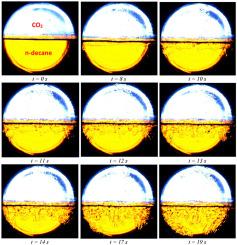Gas Science and Engineering Pub Date : 2021-07-28 , DOI: 10.1016/j.jngse.2021.104113 Widuramina Amarasinghe 1, 2 , Ingebret Fjelde 1 , Ying Guo 1, 2

|
CO2 convective mixing has been extensively studied for CO2 dissolution in saline water but very limited with the presence of oil. The objective of this work was to visually study the supercritical CO2 (sCO2) dissolution and convective mixing into oil at realistic reservoir temperature and pressure conditions with and without the presence of porous media.
A specially designed high-pressure 2D-cell was used to investigate the sCO2 mixing into oil phases. Schlieren imaging method was used as the visualization method. The experiments were carried out at 100 bar and 50 °C using n-octane, n-decane, and crude oil as the main oils. Porous media with different permeability was prepared using glass beads.
Convective fingering was found to accelerate the mixing of CO2 with n-octane and n-decane. It was not possible to visualize the CO2 convective fingering in crude oil due to the low opacity of the oil phase. The CO2 dissolution into oil phases was quite instantaneous and fast without the presence of porous media. The swelling of oil was measured as 55%, 50% and 11% for n-decane, n-octane and crude oil respectively without the presence of porous media. Boundary effects were affecting the CO2 mixing due to the circular shape of the 2D-cell. Having a water layer below the oil layer tends to dampen the CO2 transport from the oil phase to the water phase. CO2 dissolution into oil saturated porous media was slower compared to that without the presence of porous media. The mixing of CO2 was faster at higher permeability than at lower permeability. Visualization of CO2 convective mixing/fingers inside oil-saturated porous media using a Hele-Shaw cell yet to be achieved experimentally.
中文翻译:

现实油藏条件下石油中的 CO2 溶解和对流:可视化研究
CO 2对流混合已被广泛研究用于 CO 2在盐水中的溶解,但在油的存在下非常有限。这项工作的目的是在实际油藏温度和压力条件下,在多孔介质存在和不存在的情况下,直观地研究超临界 CO 2 (sCO 2 ) 溶解和对流混合到油中。
使用专门设计的高压 2D 池来研究 sCO 2混合到油相中的情况。使用纹影成像方法作为可视化方法。实验在 100 bar 和 50 °C 下进行,使用正辛烷、正癸烷和原油作为主要油。使用玻璃珠制备具有不同渗透性的多孔介质。
发现对流指法可加速 CO 2与正辛烷和正癸烷的混合。由于油相的低不透明度,无法看到原油中的 CO 2对流指法。在不存在多孔介质的情况下,CO 2溶解到油相中是非常瞬时和快速的。在不存在多孔介质的情况下,正癸烷、正辛烷和原油的溶胀率分别测量为 55%、50% 和 11%。由于二维单元的圆形形状,边界效应正在影响 CO 2混合。在油层下方具有水层往往会抑制从油相到水相的 CO 2传输。CO 2与不存在多孔介质的情况相比,在油饱和多孔介质中的溶解速度较慢。CO 2的混合在较高渗透率下比在较低渗透率下更快。使用尚未通过实验实现的 Hele-Shaw 单元对油饱和多孔介质内的 CO 2对流混合/指状件的可视化。











































 京公网安备 11010802027423号
京公网安备 11010802027423号